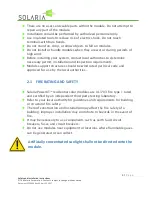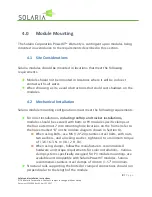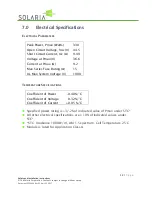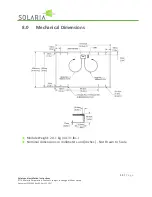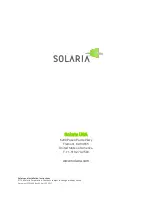
4 |
P a g e
Safety and Installation instructions
© The Solaria Corporation. Contents subject to change without notice.
Document SPS-1006 Rev 02, April 25, 2017
3.0
ELECTRICAL INSTALLATION
Caution: Avoid all electrical hazards when installing, wiring, operating,
and maintaining a module or module array.
Refer to Section 2 for more information.
The system must be installed, commissioned and maintained by a
licensed electrician unless local electrical codes determine otherwise.
Contact with DC voltage is potentially hazardous.
Do not use modules of different electrical or physical configurations in
the same DC string or inverter.
Series Connection
:
The modules may be wired in series to produce the
desired voltage output. Do not exceed the maximum system voltage
indicated on the module label.
Parallel Connection
:
The modules may be combined in parallel to produce
the desired current output provided that each series string or module is
fused prior to combining with other strings. The maximum fuse size
allowed is noted on the module label.
Connection cables and wiring shall be supported with plastic or rubber
cable ties and clips to the module support structures. Metal clips
specifically designed to be used in solar applications are allowed when
used in accordance with the manufacturer’s instructions. Module junction
boxes and metal cable ties should not be used to support cables and
wiring.
Under normal conditions, a photovoltaic module is likely to experience
conditions that produce more current and/or voltage than reported at
Standard Test Conditions (STC).
The requirements of the National
Electrical Code (NEC) in Article 690 shall be followed to address these
increased outputs. In installations not under the requirements of the
NEC, the
values of Isc and Voc marked on this module should be
multiplied by a factor of 1.25 when determining component voltage
ratings, conductor capacities, fuse sizes, and size of controls connected
to the PV output.
Refer to section 690-8 of the National Electric Code (NEC) for additional
multiplying factor of 125% (80% de-rating), which may be applicable.



